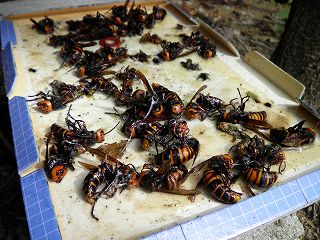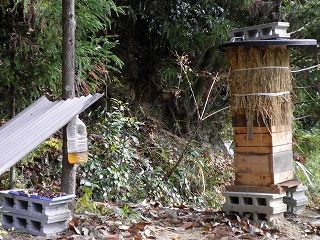Growth record 2 of Japanese honey bee
Japanese bee's dividing was made and this page was made wanting to apply the record of the growth after the first crowd had been captured on April 25, 2010. Vespine measures and measures against cold, etc. since autumn were recorded.
The ant counterplan are given to the bee house (the second crowd)

The bee doesn't go in and out a lot when going to see the bee house of the second crowd. A lot of small ants had entered the bee house when often seeing, and it seemed to carry the nest ragman honey away.
A too small ant, and the bee was the done art, and either was feeling by being done. It is ..soaking.. the water of the block if this should do some counterplan. Because the ant cannot swim in water.
The block under was filled with water by using two small boxes for the time being as shown in this photograph because there was no big container. It is likely to become it though the box manages to be a little small.
After counterplan, it was felt that going of the bee in and out increased a little. (July 20, 2010)
When water in the box was seen later, a large dividing of wrigglers had been generated. Kerosene was mixed with water a little at once. The wriggler cannot breathe and dies because the film of oil is made a surface.
Vespine measures
The vespid comes to attack it in autumn when a Japanese bee is kept. A Japanese bee has the means to oppose the vespid. However, a Japanese bee might run away when a vespine attack is intense.
Installation of sticking board for vespid

It made it to the sticking board for the vespid by using the sticking rat capture in the hundred-yen store. First of all, it captures it with the net that sells the flying vespid in the hundred-yen store. So as not to allow this vespid to die, it applies it to this sticking board gripping it with the long-nose plier. This is put near the bee house.
So as not to get wet in the rain, it roofed it as shown in the photograph under this. When it is a vespid to be alive, the sticking board one after another. The vespid to have died is removed with the long-nose plier. (November 14, 2010)
Production of vespine trap
A large PET bottle was processed, and a vespine trap was made as shown in the photograph under this. The incision is radially put on the PET bottle with scissors by about 16. Next, this incision part is bent internally. The size is not suitably cared about. The vespid that entered the inside cannot never go out easily.
An inside liquid is 1 as for the juice of 100 percent (Anything is not cared in case of not being though the juice of the grape seems to be good) and the shochu (It is sake in case of not being): It puts it at the rate in 1st place. Sugar and vinegar are suitably taken. Abounding about the shochu or sake seems to be better. The vespid enters like interest when this begins to enter, too. It enters a vespine state of fish boiled down with soy in the PET bottle.
Measures against cold of bee house

Because it had become cold, measures against cold were given to the bee house. The rice plant straw was rolled in the bee house. Because board thickness is 12mm, this bee house is a little thin.
When the hand is put outside of the bee house, I feel the heat of an inside nest. Then, it is evidence that heat runs away from the nest. Straw was rolled only in the part with the beehive of the bee house as showing in this photograph.
A vespine trap and the sticking board are put on the left of this photograph. About 100 vespids were rooted out with this vespine trap (compound of the juice, the shochu, sugar, and vinegar) and the sticking boards in the this coming fall. (November 28, 2010)